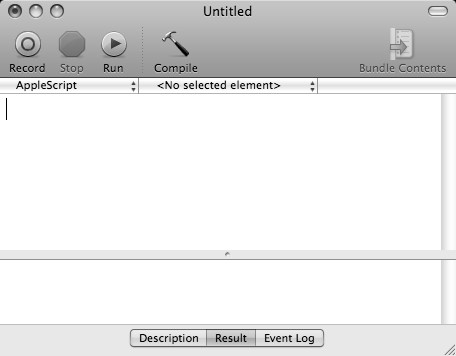Remarks

Board statistics Total number of registered users: 32,081 Total number of topics: 39,952 Total number of posts: 187,567 User information Newest registered user: Sonyminer Registered users online: 0 Guests online: 100. Learn AppleScript: The Comprehensive Guide to Scripting and Automation on Mac OS X Hamish Sanderson (Author), Hanaan Rosenthal (Author) These are available from large online book retailers and distributors in electronic and print format at quite reasonable prices (at time of writing they're around $20-$25 each). Enhanced AppleScript support in Aperture 2.0.1 combines with Mac OS X functionality to provide a new level of interactivity with page-layout applications such as Adobe InDesign CS3. For the first time, Aperture preview images can be easily placed into another application's document while maintaining direct links to the related master images in.
First stop was to Google for an AppleScript that would do the job. Though I found an simple implementation for Mac Mail there was nothing I could find for Outlook Mac 2011 that matched the features of the Windows version. Next stop was search for a free tool. Only found a commercial tool called OEAO (Outlook Exchange Account Optimizer). Apple on Friday issued a preview release of Script Editor, the authoring application for the company’s AppleScript language. Script editor 2.0 includes many enhancements and features for new.
AppleScript is a language that predates the Mac as we know it today, originating in 1993. While other scripting languages have more fully featured libraries and more robust syntax, the power of AppleScript is for automating Mac applications.


Any Mac application can include a scripting dictionary, and many that ship with macOS do. A scripting dictionary lets scripts know what items the app contains, and what actions can be performed.
A script can then use that information to automate repetitive tasks, and to form a 'glue' between different apps, forming fully customizable workflows.
Versions
| Version | OS Release | Release Date |
|---|---|---|
| 1.6 | 10.0 | 2001-03-24 |
| 1.7 | 10.1 | 2001-09-25 |
| 1.9 | 10.2 | 2002-08-23 |
| 1.9.2 | 10.3 | 2003-10-24 |
| 1.10 | 10.4 | 2005-04-29 |
| 2.0 | 10.5 | 2007-10-26 |
| 2.1 | 10.6 | 2009-08-28 |
| 2.2 | 10.7 | 2011-07-20 |
| 2.2.4 | 10.8 | 2012-07-25 |
| 2.3 | 10.9 | 2013-10-22 |
| 2.4 | 10.10 | 2014-10-16 |
| 2.5 | 10.11 | 2015-06-08 |
Exploring scripting dictionaries
The power of AppleScript lies in being able to automate many Mac applications. To find out what you can automate, you need to read an app's scripting dictionary.
To do so, launch Script Editor, and select File > Open Dictionary…

Once you choose an app, its dictionary will open up in a new window. At the top of the window, you'll see a column view (like Finder's). The first column contains various 'suites' of AppleScript terminology. The 'Standard Suite' contains items that apply to most apps (e.g. open , close , save , print ), and the other suites define custom behavior.
Your first AppleScript
- Open Script Editor.
With Mac OS X Leopard and earlier, and OS X Yosemite and later, Script Editor is located at
2.12.4Between Mac OS X Snow Leopard and OS X Mavericks inclusive, Script Editor is AppleScript Editor.
Enter the following line of code:
Click the run button.
Two things happen: Script Editor compiles your script (if there are any errors, it'll let you know what's wrong and where), and then runs it.
You will now be shown a dialog saying 'Hello World'.
You've completed your first script!
Applescript Editor Download
What the code does:
display dialog is one command, though it uses two words. This is common in AppleScript, unlike other languages which commonly require joining words together with no spaces. The display dialog command tells AppleScript to display a pop-up dialog.
This last part in 'double quotes' tells the script what text to display.
MacBook Pro, Mac OS X (10.6.6)
Applescript Editor 2.0 Download Mac Version
Posted on Mar 17, 2011 7:13 AM